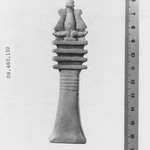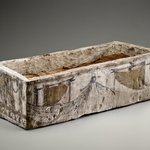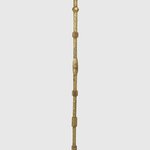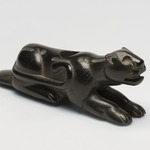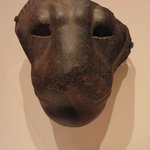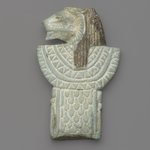

Cat (Bastet), 305 B.C.E.–1st century C.E. Wood (most likely sycamore fig - Ficus sycomorus L.), gold leaf, gesso, bronze, copper, pigment, rock crystal, glass, 26 3/8 x 7 1/4 x 19 in. (67 x 18.4 x 48.3 cm). Brooklyn Museum, Charles Edwin Wilbour Fund, 37.1945E. Creative Commons-BY (Photo: Brooklyn Museum, 37.1945E_PS9.jpg)

Cat (Bastet), 305 B.C.E.–1st century C.E. Wood (most likely sycamore fig - Ficus sycomorus L.), gold leaf, gesso, bronze, copper, pigment, rock crystal, glass, 26 3/8 x 7 1/4 x 19 in. (67 x 18.4 x 48.3 cm). Brooklyn Museum, Charles Edwin Wilbour Fund, 37.1945E. Creative Commons-BY (Photo: Brooklyn Museum, 37.1945E_37.1157E_detail_PS9.jpg)

Cat (Bastet), 305 B.C.E.–1st century C.E. Wood (most likely sycamore fig - Ficus sycomorus L.), gold leaf, gesso, bronze, copper, pigment, rock crystal, glass, 26 3/8 x 7 1/4 x 19 in. (67 x 18.4 x 48.3 cm). Brooklyn Museum, Charles Edwin Wilbour Fund, 37.1945E. Creative Commons-BY (Photo: Brooklyn Museum, 37.1945E_edited_SL1.jpg)

Cat (Bastet), 305 B.C.E.–1st century C.E. Wood (most likely sycamore fig - Ficus sycomorus L.), gold leaf, gesso, bronze, copper, pigment, rock crystal, glass, 26 3/8 x 7 1/4 x 19 in. (67 x 18.4 x 48.3 cm). Brooklyn Museum, Charles Edwin Wilbour Fund, 37.1945E. Creative Commons-BY (Photo: Brooklyn Museum, CUR.37.1945E_view01.jpg)

Cat (Bastet), 305 B.C.E.–1st century C.E. Wood (most likely sycamore fig - Ficus sycomorus L.), gold leaf, gesso, bronze, copper, pigment, rock crystal, glass, 26 3/8 x 7 1/4 x 19 in. (67 x 18.4 x 48.3 cm). Brooklyn Museum, Charles Edwin Wilbour Fund, 37.1945E. Creative Commons-BY (Photo: , 37.1945E_37.1946Ea-b_GrpA_SL4.jpg)
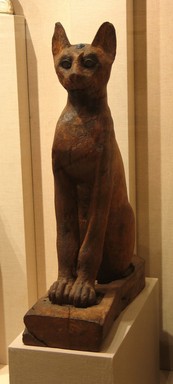
Cat (Bastet), 305 B.C.E.–1st century C.E. Wood (most likely sycamore fig - Ficus sycomorus L.), gold leaf, gesso, bronze, copper, pigment, rock crystal, glass, 26 3/8 x 7 1/4 x 19 in. (67 x 18.4 x 48.3 cm). Brooklyn Museum, Charles Edwin Wilbour Fund, 37.1945E. Creative Commons-BY (Photo: Brooklyn Museum, CUR.37.1945E_wwgA-2.jpg)

Cat (Bastet), 305 B.C.E.–1st century C.E. Wood (most likely sycamore fig - Ficus sycomorus L.), gold leaf, gesso, bronze, copper, pigment, rock crystal, glass, 26 3/8 x 7 1/4 x 19 in. (67 x 18.4 x 48.3 cm). Brooklyn Museum, Charles Edwin Wilbour Fund, 37.1945E. Creative Commons-BY (Photo: Brooklyn Museum, CUR.37.1945E_37.1157E_view1_divinefelines_2013.jpg)

Cat (Bastet), 305 B.C.E.–1st century C.E. Wood (most likely sycamore fig - Ficus sycomorus L.), gold leaf, gesso, bronze, copper, pigment, rock crystal, glass, 26 3/8 x 7 1/4 x 19 in. (67 x 18.4 x 48.3 cm). Brooklyn Museum, Charles Edwin Wilbour Fund, 37.1945E. Creative Commons-BY (Photo: Brooklyn Museum, CUR.37.1945E_37.1157E_view2_divinefelines_2013.jpg)

Cat (Bastet), 305 B.C.E.–1st century C.E. Wood (most likely sycamore fig - Ficus sycomorus L.), gold leaf, gesso, bronze, copper, pigment, rock crystal, glass, 26 3/8 x 7 1/4 x 19 in. (67 x 18.4 x 48.3 cm). Brooklyn Museum, Charles Edwin Wilbour Fund, 37.1945E. Creative Commons-BY (Photo: Brooklyn Museum, CUR.37.1945E_37.1157E_view3_divinefelines_2013.jpg)

Cat (Bastet), 305 B.C.E.–1st century C.E. Wood (most likely sycamore fig - Ficus sycomorus L.), gold leaf, gesso, bronze, copper, pigment, rock crystal, glass, 26 3/8 x 7 1/4 x 19 in. (67 x 18.4 x 48.3 cm). Brooklyn Museum, Charles Edwin Wilbour Fund, 37.1945E. Creative Commons-BY (Photo: Brooklyn Museum, CUR.37.1945E_neg_37.1945E_grpA_bw.jpg)

Cat (Bastet), 305 B.C.E.–1st century C.E. Wood (most likely sycamore fig - Ficus sycomorus L.), gold leaf, gesso, bronze, copper, pigment, rock crystal, glass, 26 3/8 x 7 1/4 x 19 in. (67 x 18.4 x 48.3 cm). Brooklyn Museum, Charles Edwin Wilbour Fund, 37.1945E. Creative Commons-BY (Photo: Brooklyn Museum, CUR.37.1945E_NegA_bw.jpg)

Cat (Bastet), 305 B.C.E.–1st century C.E. Wood (most likely sycamore fig - Ficus sycomorus L.), gold leaf, gesso, bronze, copper, pigment, rock crystal, glass, 26 3/8 x 7 1/4 x 19 in. (67 x 18.4 x 48.3 cm). Brooklyn Museum, Charles Edwin Wilbour Fund, 37.1945E. Creative Commons-BY (Photo: Brooklyn Museum, CUR.37.1945E_NegB_bw.jpg)

Cat (Bastet), 305 B.C.E.–1st century C.E. Wood (most likely sycamore fig - Ficus sycomorus L.), gold leaf, gesso, bronze, copper, pigment, rock crystal, glass, 26 3/8 x 7 1/4 x 19 in. (67 x 18.4 x 48.3 cm). Brooklyn Museum, Charles Edwin Wilbour Fund, 37.1945E. Creative Commons-BY (Photo: Brooklyn Museum, CUR.37.1945E_NegC_bw.jpg)
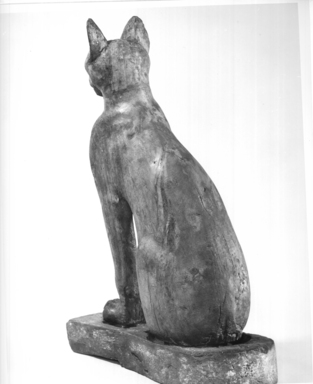
Cat (Bastet), 305 B.C.E.–1st century C.E. Wood (most likely sycamore fig - Ficus sycomorus L.), gold leaf, gesso, bronze, copper, pigment, rock crystal, glass, 26 3/8 x 7 1/4 x 19 in. (67 x 18.4 x 48.3 cm). Brooklyn Museum, Charles Edwin Wilbour Fund, 37.1945E. Creative Commons-BY (Photo: Brooklyn Museum, CUR.37.1945E_NegD_bw.jpg)

Cat (Bastet), 305 B.C.E.–1st century C.E. Wood (most likely sycamore fig - Ficus sycomorus L.), gold leaf, gesso, bronze, copper, pigment, rock crystal, glass, 26 3/8 x 7 1/4 x 19 in. (67 x 18.4 x 48.3 cm). Brooklyn Museum, Charles Edwin Wilbour Fund, 37.1945E. Creative Commons-BY (Photo: Brooklyn Museum, CUR.37.1945E_NegE_bw.jpg)

Cat (Bastet), 305 B.C.E.–1st century C.E. Wood (most likely sycamore fig - Ficus sycomorus L.), gold leaf, gesso, bronze, copper, pigment, rock crystal, glass, 26 3/8 x 7 1/4 x 19 in. (67 x 18.4 x 48.3 cm). Brooklyn Museum, Charles Edwin Wilbour Fund, 37.1945E. Creative Commons-BY (Photo: Brooklyn Museum, CUR.37.1945E_NegF_bw.jpg)

Cat (Bastet), 305 B.C.E.–1st century C.E. Wood (most likely sycamore fig - Ficus sycomorus L.), gold leaf, gesso, bronze, copper, pigment, rock crystal, glass, 26 3/8 x 7 1/4 x 19 in. (67 x 18.4 x 48.3 cm). Brooklyn Museum, Charles Edwin Wilbour Fund, 37.1945E. Creative Commons-BY (Photo: Brooklyn Museum, CUR.37.1945E_NegG_bw.jpg)
Cat (Bastet)
Egyptian, Classical, Ancient Near Eastern Art













